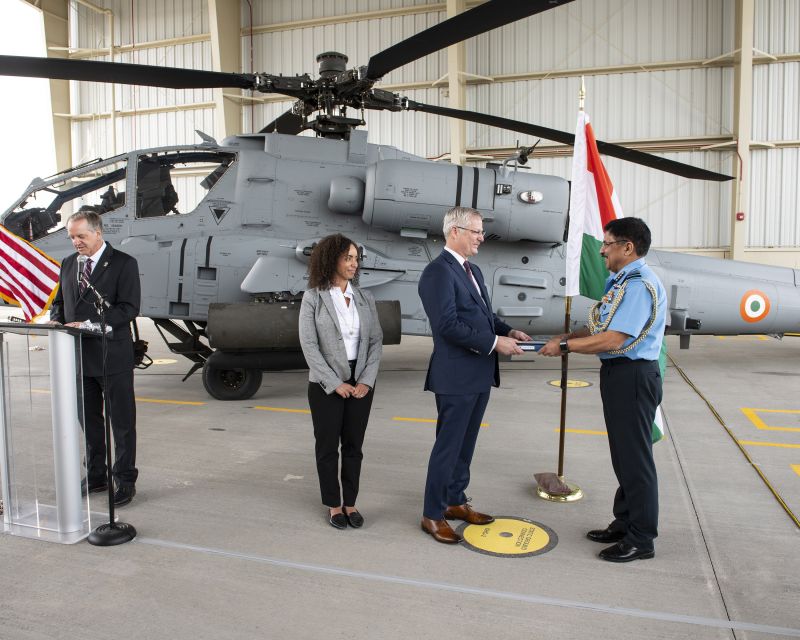Why buy major system without competitive bid?
By Rohit Srivastava

India is all set to purchase two dozen MH-60 Romeo multi-role helicopters (MRH) for Indian Navy and six AH-64E Apache attack choppers for Indian Army from the United States of America. Indian exchequers will pay USD 2.6 billion for the MH-60 Romeo and USD 930 million for Apache. This will be the follow on order for the AH-64E which is operational with Indian Air Force (IAF). In 2015, India signed a contract for 22 Apaches for around USD 2 billion of which 17 have been inducted in IAF in 2019.
The Cabinet Committee on Security (CCS), on February 19, gave its consent for the purchase of MH-60Romeo.
In addition to the two deals, US on, February 10, approved Integrated Foreign Military Sale (FMS) to India of an Integrated Air Defence Weapon System (IADWS) for an estimated cost of $1.867 billion which includes NASAMS II missile defence system.
The USD 3.5 billion for MH-60 and Apache deals will mark the upcoming state visit of the US President Donald Trump from February 24-25.
These deals are being made to sweeten the visit of the US president Donald Trump who is on a two day state visit to India on February 24-25.
Indian Navy is pursuing another procurement programme for 123 Multi-role Helicopter (NMRH) under the Strategic Partnership Model where in a platform will be selected through global competition and will be manufactured by an Indian partner locally.
This doesn’t set the right template.
On one hand, India is purchasing helicopter through FMS route and the same helicopter can participate in NMRH tender, doesn’t this defeat the very purpose of the global bid?
During the bidding process of 123 NMRH tender, what will be the justification of technical evaluation when one of the contender platforms will be under procurement? And what if any other platform outperforms or reaches commercial round and gives a better deal then will it not raise serious and genuine questions on the purchase of MH-60R through FMS route?
Indian Air Force is facing a similar problem in its 110 fighter procurement programme where the six contenders of MMRCA are back competing with one another. When India sent out Request for Information (RFI) for 110 fighters, the first question which everyone asked was that will there be another technical trial as the Rafale had outperformed everyone and came as aircraft of choice?
A section of government is pushing for the same follow on model for additional Rafale aircraft instead of a single contract for 110 fighters. One would not be surprised if 123 NMRH will also face the same fate.
On the other hand, the plan to procure NASAMS II, which is not a strategic air defence system, without any competitive bidding raises concerns. India is procuring air defence system from different countries that are incompatible with each other. At a time when India is preparing itself for the induction of S-400 long-range air defence system, going ahead with the NASAMS II to add another layer to Indian multi-layered air defence umbrella, doesn’t seem well thought out plan. NASAMS would be an odd induction in the Indian air defence tier.
India has already developed and inducting the Indo-Israeli Barak-8 surface-to-air missile system and indigenously developed Akash missile system to provide air defence in the range of 25-70 kilometre.
NASAMS II uses American air to air 100 km range AIM-120 C7 missile which gives a range of around 25 km in surface to air role.
India has already developed Astra missile which is comparable to AIM-120 then why not develop an air defence system akin to NASAMS. Moreover, to save development time, India can always take help from friendly nations with expertise in developing a similar system.
Any future air defence system must be compatible with Russian S-400 and homemade systems like Akash, Barak 8 and Ballistic Missile Defence system. This has become even more significant as in next three years India is going to have a tri-service nation-wide integrated Air Defence Command.
Similarly, India has already developed Light Combat Helicopter (LCH). It is time India should focus on developing LCH into Apache like heavy attack chopper instead of purchasing more Apaches.
Procuring in small number is not an economical way of procurement. One of the prime reasons for the limited success of projects like MBT Arjun, Akash, Pinaka etc is small orders which do not give cost benefits to the user. Moreover, the limited rate of production does not give financial scope for the upgrade programme. In the case of imported system, the odds are more in favour of exporters.
It is time India should follow a strict policy of competitive bidding for the non-strategic weapons system. And for platforms like fighter and submarines, India should go for co-production or co-development.




